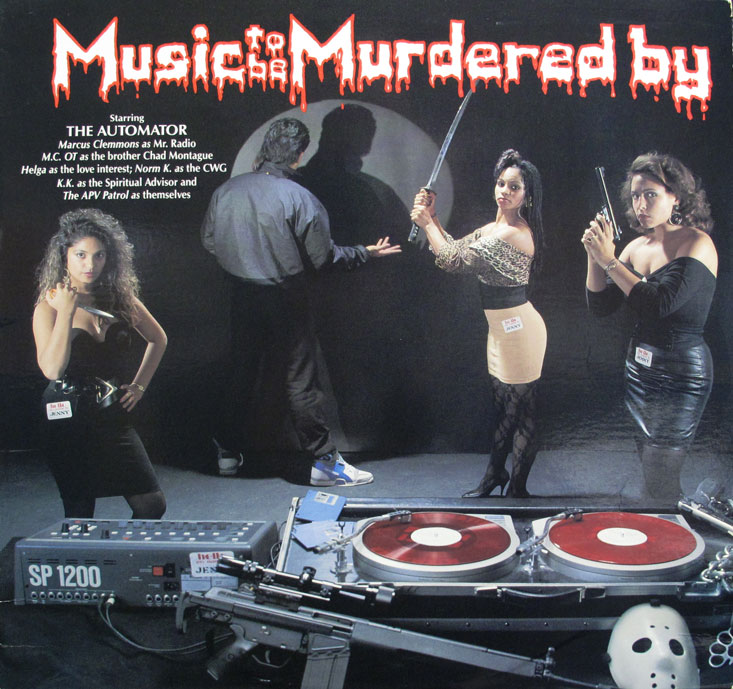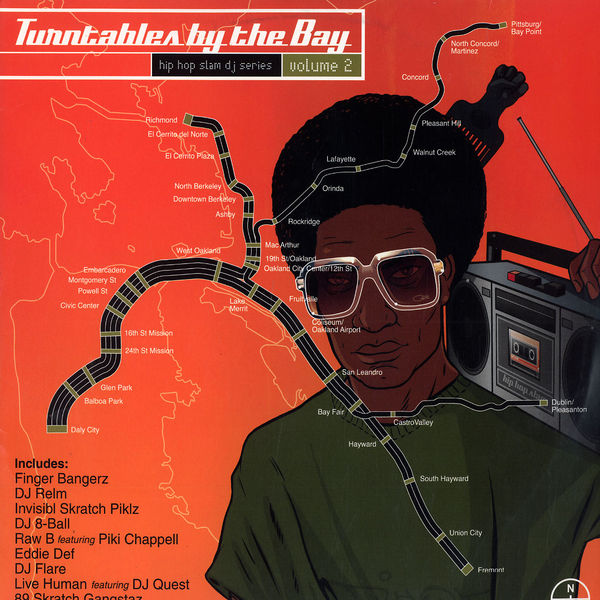
A Friday Afternoon with Billy Jam
When he moved from Oakland to New York five years ago, Billy Jam brought his radio show—which he'd been doing in the Bay Area, on a wide range of stations (from KUSF to WiLD 107)—to the legendary freeform radio station WFMU, in Jersey City, New Jersey.
This Friday, during his weekly time slot (12 to 3pm, California time), Billy Jam will broadcast his show remotely, from the Oakland Museum of California.
The show is a reliably chaotic and entertaining mix of new and classic hip hop. Billy's first love is hip hop's underground, but, true to WFMU's commitment to the freeform format, he makes a practice of leaping generic boundaries, incorporating a broad selection from rap's infinite sub-genres and beyond. An average show features a few interviews (most recently: Talib Kweli, Schoolly D, DJ Shadow, Saigon); cut-up speeches from the news (Glenn Beck, Obama) played over hip-hop instrumentals; digressive, bizarre mic-breaks (featuring plenty of echo); punk, soul, and novelty singles; and a colossal raft of top-shelf hip hop.
When Billy came by the museum this week to prepare for Friday's remote broadcast, we sat for a few minutes to talk about what he had planned. The DJ looked nothing like I imagined he would after hearing him on the air—I might have been picturing an Irish Leo Fitzpatrick, for some reason. After three decades in the U.S., Billy retains a slight accent; in his mouth, Stones Throw (a label he greatly admires) ends up sounding a bit like "Stones Troew."
THE OAKLAND STANDARD: What's going to happen here at noon on Friday?
BILLY JAM: The name of the show I do is "Put the Needle on the Record", and we're calling Friday's show "Put the Needle on the History of the California DJ." We have a lot of different DJs from the Bay Area, including DJ Pam the Funkstress, who people know from being in the Coup; DJ Quest, who people might know from his solo work as well as his long-time work with the Bulletproof Space Travelers; DJ Platurn, a very active DJ around Oakland; Dee Android and Celski, a Filipina DJ duo. There'll be a guy called DJ Centipede, who also records under the name Mophono. He has a new album coming out where you can drop the needle anywhere and it picks up on the beat. Mia Moretti, who's DJing the Oakland Standard party that evening, is going to stop by and talk about the type of DJing she does—about being a sort of celebrity DJ in New York. There's DNZ, a Bay Area DJ who's just back from Japan, and Mista-B, who's a part of the 4ONEFunk crew from San Francisco. Finally, there's a guy called Dawgisht, who'll be making live beats.
OS: How are live beats made?
BJ: Well, he uses an Amiga. Sometimes he brings a keyboard. And then he'll play live beats off of different computers, and just mix them in on the spot, improvising.
So all of these people will do little sets. They'll be short workshops in the art of the DJ—a semi-tutorial with DNZ and Mista-B teaching a how-to on the basics. We'll talk about the what a hip hop DJ does, focusing on technique: how to take two turntables and a mixer and turn that into an instrument. And of course we'll discuss how all of this is unique to California.
OS: And this will all be broadcast on WFMU?
BJ: For three hours. I like the interactive part of the Oakland Museum of California, the idea that people will be able to wander up and be a part of what we're doing on the air. And it's free: you need to pay to enter the galleries, but we'll be in the museum's Oak Street Plaza, free and open to the public. We'll have some album covers on display behind us for people to look at, too. The album covers tell the history, in a way, of Bay Area DJs. Of course, even if you had all the space in the world, you'll always omit something, but we'll do the best we can to celebrate the art of the DJ.
OS: What albums are you putting in that display?
BJ: They're pretty much all independent releases—it's not Jay-Z or Kanye West. This is all underground stuff. For example, this is a 1989 release—Dan the Automator, Music to be Murdered By. Years later, he went on to work with Kool Keith—but this one is just all crazy beats.

These records here, produced by DJ Qbert, are the original battle records. Battle records are basically sound records, all different sound effects. Only DJs use them. With some, on one side you'll have the music, the beats, and on the other side -- or maybe both sides—there'll be a series of sounds: "ah… fresh…kllshhsk…" Hi-hat sounds, maybe a little sample of Biz Markie, a little bit of a saxophone, maybe bit of an Aretha Franklin or Lyn Collins vocal. As the DJ teases it in, you hear a bit of it, and you know what it is, but you don't fully get to hear it. It's barely recognizable, but it gives you the feel of it, then moves along to the next thing before you've figured out what you were feeling based on the memory of the sample being scratched.
OS: Why is that good for battles?
BJ: Because then you have them all together. So instead of having to go in search of that one little bit of Biz Markie going "unnhwr", and just one little bit of KRS-ONE, one little bit of a sound from Public Enemy, you have it all together. You have all the beats together, too, on the flipside. So with two copies of the same record, you're ready to go.

OS: How did you come to hip hop?
BJ: I'm from Ireland, and I moved over to America at the very end of the '70s. I arrived in New York just when hip hop was starting. I got into it right away. I moved to California in the end of '81, and started listening to hip hop, but there wasn't a lot of it. Around 1986, I thought, you know what, I'm going to commit myself to this. I had just produced a big Bay Area rap contest in 1986 on KALX and had gotten such an overwhelming response in tapes sent in, I sensed there was a vibrant musical movement bubbling under the Bay. In addition to work at many radio stations in the Bay Area — commercial, non-commercial, pirate — I also worked as a journalist, reporting on this local art form in the context of hip hop in general. Then I got heavily into turntablism into the '90s.
OS: Your current home at WFMU has an amazingly, even aggressively diverse mix of programming—but yours is one of the only rap shows on the schedule. How does hip hop fit into the freeform format?
BJ: It's a good point, and actually, just last Friday I was playing a New York artist, Saigon. His album is just coming out, and his music could be construed as… sort of mainstream-sounding. So someone called me up on the phone, and they were like, "Yo, excuse me, when are you gonna play the weird stuff again?" Of course, it was a valid point, but it was sort of insulting, too. I guess he wasn't enjoying it. But turntablism is experimental music. I first got in touch with WFMU because they were playing all the releases I put out on my label—different releases from the Bay Area, the Invisibl Skratch Piklz, all turntablists. Scratch music is like free-form jazz. The thing about hip hop is it's such a broad swath of music: There's the commercial stuff, there's KMEL—which, yeah, how would that fit in? But then there's the weird scratch stuff. When I'm on the air, I keep all that in mind. I might wander off, play a punk-rock song, other types of music, too, but give it a freeform approach.
It'll be that way at the museum remote broadcast. A DJ session is like free-form jazz; it's an improv session. Someone jumps in and starts scratching. When you see it live, you can better appreciate what they're really doing. I'm hoping that on Friday we won't play any songs—no pre-recorded material. Everything will be live. It may not be perfect, but it'll be truly original. It's never been heard before in exactly the same way. That's where they're connected, the DJ and the artist.
Projects








